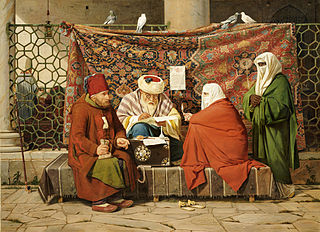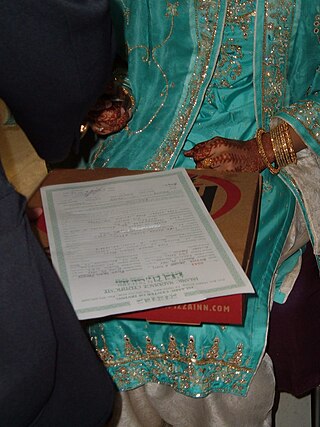Related Research Articles

Sharia is a body of religious law that forms a part of the Islamic tradition based on scriptures of Islam, particularly the Quran and hadith. In Arabic, the term sharīʿah refers to God's immutable divine law and this referencing is contrasted with fiqh, which refers to its interpretations by Islamic scholars. Fiqh, practical application side of sharia in a sense, was elaborated over the centuries by legal opinions issued by qualified jurists and sharia has never been the sole valid legal system in Islam historically; it has always been used alongside customary law from the beginning, and applied in courts by ruler-appointed judges, integrated with various economic, criminal and administrative laws issued by Muslim rulers.
The Uniform Civil Code is a proposal in India to formulate and implement personal laws of citizens which apply on all citizens equally regardless of their religion, gender and sexual orientation. Currently, personal laws of various communities are governed by their religious scriptures. Implementation of a uniform civil code across the nation is one of the contentious promises pursued by India's ruling Bharatiya Janata Party. Personal laws are distinguished from public law and cover marriage, divorce, inheritance, adoption and maintenance. While Article 25-28 of the Indian Constitution guarantees religious freedom to Indian citizens and allows religious groups to maintain their own affairs, article 44 of the constitution expects the Indian state to apply directive principles and common law for all Indian citizens while formulating national policies.

Mohd. Ahmad Khan v. Shah Bano Begum [1985 (1) SCALE 767 = 1985 (3) SCR 844 = 1985 (2) SCC 556 = AIR 1985 SC 945], commonly referred to as the Shah Bano case, was a controversial maintenance lawsuit in India, in which the Supreme Court delivered a judgment favouring maintenance given to an aggrieved divorced Muslim woman. Then the Congress government enacted a law with its most controversial aspect being the right to maintenance for the period of iddat after the divorce, and shifting the onus of maintaining her to her relatives or the Waqf Board. It was seen as discriminatory as it denied right to basic maintenance available to Muslim women under secular law.
A qāḍī is the magistrate or judge of a sharīʿa court, who also exercises extrajudicial functions such as mediation, guardianship over orphans and minors, and supervision and audition of public works.
In Islam, a mahr is the obligation, in the form of money, possessions or teaching of verses from the Quran by the groom, to the bride at the time of the Islamic Wedding. While the mahr is often money, it can also be anything agreed upon by the bride such as jewelry, home goods, furniture, a dwelling or some land. Mahr is typically specified in the marriage contract signed upon marriage.

In Islam, nikah is a contract exclusively between a man and woman. Both the groom and the bride are to consent to the marriage of their own free wills. A formal, binding contract – verbal or on paper – is considered integral to a religiously valid Islamic marriage, and outlines the rights and responsibilities of the groom and bride. Divorce in Islam can take a variety of forms, some executed by a husband personally and some executed by a religious court on behalf of a plaintiff wife who is successful in her legal divorce petition for valid cause. Islamic marital jurisprudence allows Muslim men to be married to multiple women.
Throughout history, women in Iran have played numerous roles, and contributed in many ways, to Iranian society. Historically, tradition maintained that women be confined to their homes to manage the household and raise children. During the Pahlavi era, there was a drastic social change towards women's desegregation such as ban of the veil, right to vote, right to education, equal salaries for men and women, and the right to hold public office. Women were active participants in the Islamic Revolution. Iran's constitution, adopted after the Islamic Revolution in 1979, proclaims equality for men and women under Article 20, while mandating legal code adhering to Sharia law. Article 21 of the constitution as well as a few parliament-passed laws give women rights such as being allowed to drive, hold public office, and attend university but not wearing a veil in public can be punished by law; and when in public, all hair and skin except the face and hands must be covered. However, this is often not enforced; notably in recent years, Iranian women have started a number of groups to rebel against the government's oppressive policies and reclaim their independence and rights.
Rajm in Islam refers to the Hudud punishment wherein an organized group throws stones at a convicted individual until that person dies. Under some versions of Islamic law (Sharia), it is the prescribed punishment in cases of adultery committed by a married person which requires either a confession from either the adulterer or adulteress, or producing four witnesses of sexual penetration.
Islamic feminism is a form of feminism concerned with the role of women in Islam. It aims for the full equality of all Muslims, regardless of gender, in public and private life. Islamic feminists advocate for women's rights, gender equality, and social justice grounded in an Islamic framework. Although rooted in Islam, the movement's pioneers have also utilized secular, Western, or otherwise non-Muslim feminist discourses, and have recognized the role of Islamic feminism as part of an integrated global feminist movement.
Nikah halala, also known as tahleel marriage, is a practice in which a woman, after being divorced by triple talaq, marries another man, consummates the marriage, and gets divorced again in order to be able to remarry her former husband. Nikah means marriage and halala means to make something halal, or permissible. This form of marriage is haram (forbidden) according to the hadith of Islamic prophet Muhammad. Nikah halala is practiced by a small minority of Muslims, mainly in countries that recognise the triple talaq.
Divorce according to Islamic law can occur in a variety of forms, some initiated by a husband and some by a wife. The main categories of Islamic customary law are talaq, khulʿ and faskh. Historically, the rules of divorce were governed by sharia, as interpreted by traditional Islamic jurisprudence, though they differed depending on the legal school, and historical practices sometimes diverged from legal theory.

An Islamic marriage contract is considered an integral part of an Islamic marriage, and outlines the rights and responsibilities of the husband and wife or other parties involved in marriage proceedings under Sharia. Whether it is considered a formal, binding contract depends on the jurisdiction. Islamic faith marriage contracts are not valid in English law, nor American Law. Because of this, some Islamic Marriage Officiants will only officiate a marriage after the couple had been legally married in court.

The experiences of Muslim women vary widely between and within different societies. At the same time, their adherence to Islam is a shared factor that affects their lives to a varying degree and gives them a common identity that may serve to bridge the wide cultural, social, and economic differences between them.
Khulʿ (Arabic: خلع, also called khula, is a procedure based on traditional jurisprudence, that allows a Muslim woman to initiate a divorce by returning the mahr and everything she received from him during their life together, or without returning anything, as agreed by the spouses or judge's decree, depending on the circumstances.

The relationship between Islam and domestic violence is disputed. Even among Muslims, the uses and interpretations of Sharia, the moral code and religious law of Islam, lack consensus. Variations in interpretation are due to different schools of Islamic jurisprudence, histories and politics of religious institutions, conversions, reforms, and education.

In the Ottoman Empire, women enjoyed a diverse range of rights and were limited in diverse ways depending on the time period, as well as their religion and class. The empire, first as a Turkoman beylik, and then a multi-ethnic, multi-religious empire, was ruled in accordance to the qanun, the semi-secular body of law enacted by Ottoman sultans. Furthermore, the relevant religious scriptures of its many confessional communities played a major role in the legal system, for the majority of Ottoman women, these were the Quran and Hadith as interpreted by Islamic jurists, often termed sharia. Most Ottoman women were permitted to participate in the legal system, purchase and sell property, inherit and bequeath wealth, and participate in other financial activities, rights which were unusual in the rest of Europe until the 19th century.
The role of women in Egypt has changed throughout history, from ancient to modern times. From the earliest preserved archaeological records, Egyptian women were considered equal to men in Egyptian society, regardless of marital status.

The Gambia is a Muslim majority country, with Muslims constituting 96.4% of the population, some 3.5% are Christian, and 0.1% practice other religions.

Stoning, or lapidation, is a method of capital punishment where a group throws stones at a person until the subject dies from blunt trauma. It has been attested as a form of punishment for grave misdeeds since ancient history.

The legal system of Saudi Arabia is based on Sharia, Islamic law derived from the Quran and the Sunnah of the Islamic prophet Muhammad. The sources of Sharia also include Islamic scholarly consensus developed after Muhammad's death. Its interpretation by judges in Saudi Arabia is influenced by the medieval texts of the literalist Hanbali school of Fiqh. Uniquely in the Muslim world, Sharia has been adopted by Saudi Arabia in an uncodified form. This, and the lack of judicial precedent, has resulted in considerable uncertainty in the scope and content of the country's laws. The government therefore announced its intention to codify Sharia in 2010, and, in 2018, a sourcebook of legal principles and precedents was published by the Saudi government. Sharia has also been supplemented by regulations issued by royal decree covering modern issues such as intellectual property and corporate law. Nevertheless, Sharia remains the primary source of law, especially in areas such as criminal, family, commercial and contract law, and the Qur'an and the Sunnah are declared to be the country's constitution. In the areas of land and energy law the extensive proprietorial rights of the Saudi state constitute a significant feature.
References
- ↑ A. Jafar; E. Casanova (10 December 2013). Global Beauty, Local Bodies. Springer. ISBN 978-1137365347.